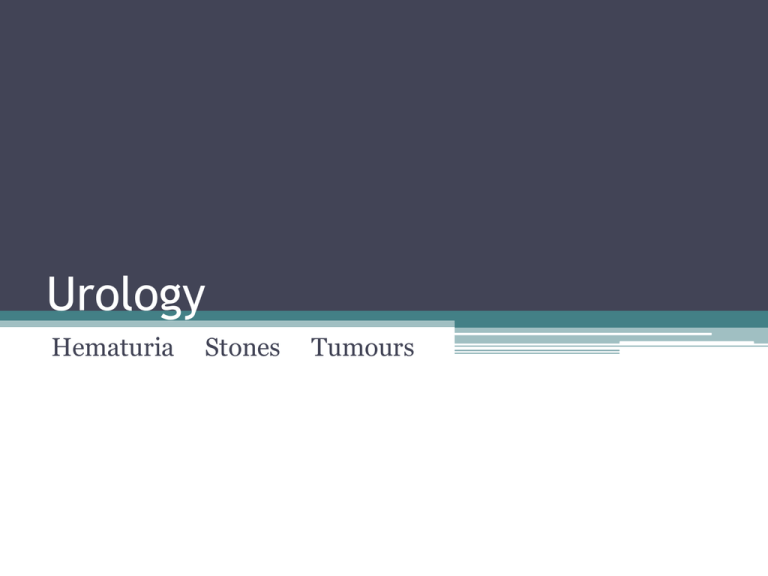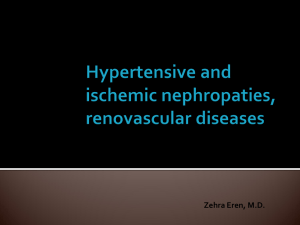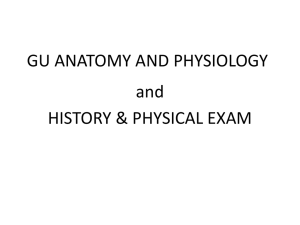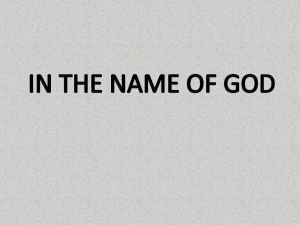Urology
advertisement

Urology Hematuria Stones Tumours Outline • Hematuria ▫ DDx ▫ General Work up • Renal Colic ▫ Stones • Malignancy ▫ Renal ▫ Bladder • Scrotal masses Hematuria • Objectives ▫ 1. Taking a Hx. ▫ 2. Lab & Radiologic Invx’s. ▫ 3. Which pt’s to refer to Urologist. Hematuria Hematuria General Approach Hematuria Pre-renal •Myo/hemoglobinuria •Coagulation disorders •Pseudohematuria •(beets, dyes, laxatives) Renal •Glomerulonephritities •AV Fistulas •Vascular Malformations •Infection •Tumor Post Renal • Stones •Infection • Trauma •Tumors •GU Endometriosis Hematuria • Etiology by Age Age Etiology in order of frequency 0-20 Glomerulonephritis, UTI, congenital anomalies 20-40 UTI, stones, bladder tumor 40-60 Male: Bladder tumor, stones, UTI Female: UTI, stones, bladder tumor >60 Male: BPH, bladder tumor, UTI Female: Bladder tumor, UTI Hematuria General Approach Hematuria Pre-renal •Myo/hemoglobinuria •Coagulation disorders •Pseudohematuria •(beets, dyes, laxatives) Renal •Glomerulonephritities •AV Fistulas •Vascular Malformations •Infection •Tumor Post Renal • Stones •Infection • Trauma •Tumors •GU Endometriosis Hematuria DDx ▫ ▫ ▫ ▫ Stones Infections Tumours Trauma Hematuria HPI • Stones: ▫ Flank/Abdo pain, dysuria, PHx Stones. • Infection: ▫ Suprapubic pain, dysuria, frequency, fever/chills +/flank pain. • Malignancy ▫ Wt loss, night sweats, flank pain, voiding changes, Occupational Hx (petroleum exposure), smoking Hx, FMHx of Cancer • Trauma ▫ Recent encounters with Chuck Norris. Gross Hematuria Invx • Laboratory Work up: ▫ 1. CBC Hgb - severity of blood loss. WBC – infection. Platelet loss/coagulopathy. ▫ 2. Cr Renal impairment. ▫ 3. INR/PTT Coagulopathy. ▫ 4. U/A Leukocytes, Nitrites – Infection. R&M – if dysmorphic RBC’s +/- Protein = Glomerular cause, crystals stones. C&S – Infection. Hematuria Invx Radiology Investigations • Painless Gross Hematuria ▫ Triphasic CT: arterial/venous/ureteric phases • Microscopic Hematuria ▫ Start with Renal U/S. • Flank Pain ▫ Plain film KUB, CT KUB (non con). • Signs of infection ▫ Start with U/S, if findings may consider CT with contrast Imaging Modality Pros IVP 1. Good choice for suspected 1. Expensive. stones or Transitional 2. Radiation. tumors of bladder or ureter. 3. May miss small renal Tumors. 4. Contrast allergies, Nephrotoxic Hematuria Cons U/S 1. No ionizing radiation. 2. Inexpensive. 3. Can identify tumor or stone 1. May miss stones, ureteric & bladder tumors. 2. Unable to differentiate tumors from blood clot. CT non contrast 1. Used for Renal Colic – 1. Ionizing radiation best at identifying stones exposure. 2. Accurate staging of 2. Risk to fetus in Malignancy if present Pregnancy CT contrast (triphasic) 1. Useful identifying abscesses, fluid collections. 2. Ureteric phase – identifies filling defects. 1. Contrast allergy. 2. Contrast makes visualizing stones difficult Hematuria Referral • When to refer to Urologist? ▫ Gross hematuria NEED cystoscopy +/- Retrograde Pyelogram!! ▫ Pt’s with GU Malignancies, stones, trauma. • What should be done prior to referral? ▫ Hx, PE, Lab Invx’s, Imaging ▫ Initial management and stabilization of pt. Retrograde Pyelogram Hematuria Acute Rx • ABC’s. ▫ Stabilize Pt, Blood products if needed. • Invx to determine cause ▫ Treat underlying cause. • Continuous Bladder Irrigation ▫ Call Urology. ▫ Manually irrigate all clots out of bladder first! • Surgical management ▫ ▫ ▫ ▫ Cystoscopy + Fulgaration. Hyperbaric Oxygen IR embolization. Cystectomy and Urinary diversion. Hematuria Summary 1. Painless Gross Hematuria ▫ Malignancy until proven otherwise. ▫ Rarely asymptomatic Hx.. Hx.. Hx.. ▫ ▫ ▫ ▫ Hx, PE Lab: CBC, Cr, U/A C&S, INR/PTT Imaging: CT or U/S Referral to Urologist: cystoscopy +/- Retrograde pyelogram 2. Stones, infections & trauma 3. Workup 4. Management ▫ Stabilize Pt, +/- CBI, +/- Surgical intervention Hematuria Cases • Geeyu Malignansey, a 67 yo female with 114 pk/yr smoking hx presents with Gross Hematuria. • Wazun Mi, 23 yo male minding his own business gets stabbed to the flank, while voiding and notices he urine becomes red… • 24 yo Engineering student comes in with dysuria after holding her urine for 14 hours playing ‘Call of duty’, she has leuks, nitrites and RBC’s on U/A… Outline • Hematuria ▫ DDx ▫ General Work up • Renal Colic ▫ Stones • Malignancy ▫ Renal ▫ Bladder • Scrotal masses Stones Renal Colic Objectives; 1. Give a differential diagnosis for acute flank pain including two life-threatening conditions 2. Describe the laboratory and radiologic evaluation of a patient with renal colic 3. Know 4 different kinds of kidney stones and the risk factors for stone formation 4. Know 3 indications for emergency drainage of an obstructed kidney Renal Colic DDx • Life Threatening: ▫ Abdominal Aortic Dissection ▫ Abdominal Aortic Aneurysm Rupture ▫ Appendicits ▫ Ectopic Pregnancy ▫ Septic Stone • GI ▫ ▫ ▫ ▫ ▫ ▫ ▫ ▫ Cholecystitis Biliary Colic Acute Pancreatitis Diverticulitis Duodenal Ulcer Inflammatory Bowel Disease Viral gastritis Splenic Infarct •Gyne •Pelvic inflammatory Disease •Ovarian Torsion/Rupture •Endometriosis •GU •Renal/Ureteric Calculi •Renal Abscess •Pyelonephritis •Renal Vein Thrombosis •Acute Glomerulonephritis •Other •Acute lumber disc herniation •Herpes Zoster •Fitz-Hugh-Curtis Syndrome Renal Colic Invx • Rocky, a 32 yo Male comes to ED with microscopic hematuria and is writhing with Lt Flank pain. • What Laboratory Invx’s do you order? • What initial imaging do you order? Stones – Acute Lab Invx’s • CBC ▫ WBC – increased indicates inflammation or infection. • Creatinine ▫ Assess for impaired renal function (obstruction). • Urine Microscopy ▫ Bacteriuria, pyuria, pH Renal Colic – 1st Imaging Test • Plain Film KUB! ▫ ~85% of stones are Radio-opaque on plain film. ▫ No info on degree of obstruction though. Renal Colic – Other imaging options IVP • Intravenous Pyelogram • Visualizes most stones (radiolucent stones will appear as filling defects) • Excellent Functional Study • Requires IV contrast, thus risk of allergic reactions and nephrotoxicity Renal Colic – Radiologic Evaluation • CT Scan, hold the contrast. • Aka CT-KUB. • Fast Inexpensive • Imaging choice in most emergency rooms. • Degree of obstruction inferred by presence of hydronephrosis. Stones - Factoids • They are common! ▫ Lifetime risk in North American Male is 1 in 8. ▫ M:F ratio is 3:1 • Presenting complaint ▫ Renal colic due to acute obstruction of ureter by stone. • Initial Evaluation ▫ Focuses on excluding other potential causes of abdominal or flank pain. • Non-obstructing stones ▫ Should not cause pain unless they are associated with Urinary tract infection. Ureteric Stone • 3 Common sites of Obstruction Ureteric Stones • Spontaneous passage? Size Likelihood 4mm or less 90% 5-7mm 50% 8mm or larger 20% • Pharmacologic aid in spontaneous passage? ▫ Alpha blockers! Flomax Renal and Ureteric Stones • So you have established that there is a stone. ▫ When is ‘immediate’ referral to a Urologist Necessary? Immediate Referral to Urology • Obstructed ureter + Fevers/chills, bacteriuria or elevated WBC ▫ Risk of Urosepsis - emergency • Obstructed Ureter + Insulin dependent DM ▫ Risk of papillary necrosis or emphysematous pyelonephritis • Solitary Kidney • Significant co-morbid conditions ▫ Eg. CHF, pregnancy etc. Common Types of Stones Renal Stones Calcium Oxalate Calcium Phosphate Struvite (infections stones) Uric Acid Calcium Oxalate • Most common type. • Risk Factors: ▫ Dietary Hyperoxaluria: chocolate, nuts, tea, strawberries, peanut butter, cabbage or excessive restriction of dietary calcium. • Hypercalciuria ▫ Inherited increased absorption, or incr PTH • Dietary Hypercalciuria Calcium Phosphate • Second most common stone type. • Often seen in pt’s with Metabolic Abnormalities: ▫ Primary Hyperparathyroidism. ▫ Distal Renal tubular acidosis. ▫ Hypercalcemia due to Malignancy or Sarcoid. Uric Acid • Radiolucent on Plain X-Rays, but is visualized on CT scan • Risk Factors: ▫ Persistent Acidic urine: ie l Low urine volumes Chronic diarrhea Excessive sweating Inadequate fluid intake ▫ Gout (Hyperuricemia) ▫ Excess dietary purine (Meataholics) ▫ Chemotherapy for lymphoma, leukemia Struvite (Infection Stones) • Composed of MAP ▫ Magnesium + Ammonium Phosphate & Calcium • Can only form if urine pH >8.0! ▫ Thus: usually only in presence of urease +ve bacteria Proteus, Klebsiella, Providentia, Pseudomonas, Staph Aureus Note: E Coli does NOT produce urease • Tend to form Staghorn stones Relieving Obstruction Obstructed Stone Retrograde Ureteric Stents Percutaneous Nephrostomy Tubes Remove stone Ureteric Stents • “Double J Stents” ▫ Stay in place b/c of curled ends ▫ Can place these Antegrade or Retrograde ▫ Typically requires General Anesthetic. ▫ Low risk of bleeding. Percutaneous Nephrostomy Tubes • “Neph Tubes” ▫ Placed under local anesthetic by Interventional Radiology ▫ Increased Risk of Bleeding. Treating/Removing Stones • Ways to Treat stones. ▫ Conservative passage + Alpha Blocker (Flomax) + Hydration + NSAID (if Normal GFR) ▫ Extracorporeal Shockwave Lithotripsy (ESWL) ▫ Ureteroscopy + Basket or Laser ▫ Percutaneous Nephrolithotomy Treating Stones • Conservative passage + Alpha Blocker (Flomax) + Hydration + NSAID (if Normal GFR) ▫ Indications Pain can be controlled with Ketorolac + Narcotic No renal impairment No Intractable Vomiting (aka pt not hypovolemic) No sign of infection. No previous failed trials of conservative passage. Treating Stones • Extracorporeal Shockwave lithotripsy ▫ Indication: <~1.5cm renal or ureteric stone. ▫ Stone is localized by XRay. ▫ ~3000 Shocks targeted to gradually fragment stone. ▫ Fragments passed in urine. Treating Stones • Ureteroscopy ▫ + Basket If stone is small enough to adequately remove by basket. ▫ + Holmium Laser If stone is ‘impacted’ or cannot simply be basketed out. Treating Stones • Percutaneous Nephrolithotomy ▫ Indications Large Proximal ureteric or Renal Calculi >~1-1.5cm Treatment of Staghorn Calculi ▫ Risks: Bleeding Renal Perforation or Avulsion • http://www.youtube.com/watch?v=irKCgFrAO RA Outline • Hematuria ▫ DDx ▫ General Work up • Renal Colic ▫ Stones • Malignancy ▫ Renal ▫ Bladder • Scrotal masses Renal Mass Objectives: 1. Give a differential diagnosis for a solid mass in the kidney. 2. Describe the evaluation of a patient with a suspected renal cell carcinoma 3. Give three indications for a partial nephrectomy rather than a radical nephrectomy for renal cell carcinoma. Renal Tumors • Presentation: ▫ Incidental finding! ▫ Triad: Flank pain, hematuria, palpable mass (not common) • How do you ‘work-up’ a Renal mass? Renal Mass Investigations • Imaging ▫ CT Abdo pelvis + contrast Characterize Mass and assess for tumor extension, IVC thrombus, Nodes, Mets, abnormalities to contralateral kidney. ▫ CXR Assess for mets • Laboratory ▫ Alk Phos (bone mets) ▫ LE’s hepatic/portal vein involvment ▫ Calcium • Biopsy? ▫ Recommended only when Dx is unclear. Why Investigate Calcium? • Bone Mets or Paraneoplastic syndrome! ▫ 20-30% of RCC have Paraneoplastic Syndrome Increased ESR Wt loss, cachexia Fever Anemia Hypertension (incr Renin) Hypercalcemia (PTH-like Substance) Incr ALP Polycythemia (incr EPO production) Stauffer’s syndrome – reversible hepatitis Renal Tumors Renal Mass (U/S or CT) Benign •Oncocytoma •Angiomyolipoma •Psuedotumour •Dromedary Hump •Hypertrophied column of Bertin •Compensatory Hypertrophy etc Malignant •Renal Cell Carcinoma •Transitional Cell Carcinoma •Wilms Tumour (peds) •Metastasis •Lymphoma/leukemia •Lung •Breast Benign Tumors • Know that they exist. • DDx: • Oncocytoma, angiomyolipoma (1-2% malignant), papillary adenoma, pseudotumors etc…. • Differentiating pseudotumors from real tumors. ▫ DMSA scan Pseudotumors will have normal uptake, tumors will be decreased. Benign Renal Masses • Angiomyolipoma ▫ Diagnosed if any part of renal mass consists of adipose. Composed of Fat – smooth muscle – blood vessels ▫ Risk of hemorrhage near 50% once size >4cm Malignant Renal Cell Carcinoma • Accounts for 90% of solid renal masses. • Several different subtypes ▫ Clear Cell is most common • 25% present with Mets Renal Cell Carcinoma • Treatment ▫ Local confined mass Nephrectomy Partial Nephrectomy ▫ ▫ ▫ ▫ Solitary kidney or significant renal impairment Bilateral tumors Von Hippel-Lindau Syndrome Small tumor <4cm ▫ Metastatic RCC Combination of Nephrectomy + Chemo (Sunitinib) Renal Cell Carcinoma Five year disease-specific survival (following most effective treatment) T1 T2 T3a T3b, c T4 95% 90% 60% 25% (following complete removal of IVC thrombus) 20% N1, 2 10% – 20% M1 0% Other Malignant Renal Tumors • Renal Transitional Cell Carcinoma ▫ Because Transitional cells line renal pelvis, ureters & bladder, must perform nephroureterectomy to Rx. • Wilm’s Tumor ▫ Peds • Sarcoma • Metastasis to Kidney ▫ Leukemia, lymphoma ▫ Lung ▫ Breast Bladder Cancer Objectives: 1. State 3 risk factors for transitional cell carcinoma of the bladder 2. State the treatment options for superficial and invasive TCC of the bladder Bladder Cancer • Often presents as painless gross hematuria! ▫ Recall workup for gross hematuria: Upper tract imaging CT Abdo/pelvis Cystoscopy • Diagnosis ▫ Cystoscopy + Biopsy Transurethral resection of lesion and underlying detrusor muscle to stage tumor ▫ Urine Cytology ▫ Ct Abdo/pelvis for staging. Bladder Cancer • Risk Factors ▫ SMOKING (RR 4 vs non smokers) ▫ Occupational Exposure Aniline dyes, aromatic amines Ie. Textile manufacturing, dry cleaning, painting) ▫ Previous Cyclophosphamide (ie chemo for lymphoma) ▫ Previous Radiaiton Rx in pelvis Bladder Cancer • DDx • Transitional Cell carcinoma ▫ Most common! • Adenocarcinoma ▫ Dome of bladder, associated with Urachus. • Squamous Cell Carcinoma ▫ Associated with chronic inflammation Indwelling foley’s, bladder stones. Transitional Cell Carcinoma • Staging ▫ Non-invasive Tis, Ta, T1 disease ▫ Invasive >T1 disease (muscle invasive Treatment of Non-invasive TCC • 1. Transurethral resection of lesion • 2. PLUS intravesical chemotherapy IF: ▫ ▫ ▫ ▫ ▫ ▫ Carcinoma in-situ Multi focal tumors Unable to completely resect transurethrally Rapid recurrence after initial resection Superficial, high grade tumor Lamina propria invasion (Stage T1) Treatment of Non-invasive TCC • Intravesical Chemotherapeutic Agents: ▫ ▫ ▫ ▫ Bacille Calmette-Guerin (BCG) Mitomycin Doxorubicin Thiotepa Treatment of Non-Invasive TCC • But….IF: ▫ Persistent CIS after intravesical chemotherapy ▫ Extensive superficial tumors that cannot be resected. • Then Pt will require Radical Cystectomy and Urinary diversion for curative intent. Treatment of Invasive TCC • Radical Cystectomy • +/- Chemotherapy for metastatic disease • If palliative, may still require cystectomy if uncontrollable hematuria (requiring transfusions etc) Radical Cystectomy + Urinary Diversion • Once Bladder is removed… • Urinary diversion is needed ▫ Ileal Conduit Pros – simple, least complications Cons – abdominal stoma, no continence. ▫ Neobladder Pros – continent with use of catheters Cons – Increased surgical complications, increased risk of metabolic derrangements. Ileal Conduits Neobladders Scrotal Mass Objectives • Differential diagnosis of a scrotal mass • Know how to diagnose and treat testicular torsion • Classify testicular tumors • Treatment of testicular malignancies Approach to Scrotal Mass Scrotal Mass Infectious Anatomic Malignant •Epididymitis** •Orchitis** •Hydrocele •Inguinal hernia •Varicocele •Spermatocele •Testicular Torsion** •Appendix Testi Torsion** •Testicular tumor •Paratesticular tumor •Cystadenoma of epididymis ** = painful Approach to Scrotal Mass • Hx ▫ Pain, onset, firmness, hx of undescended testis, STD’s, LUTs, urethral discharge • PE ▫ Location of mass (testis, epididymis, scrotum) ▫ Tenderness ▫ Transilluminance • Invx’s ▫ U/A – pyuria with epididymitis ▫ U/S – ++ Sensitive and specific for testicular tumors Approach to Scrotal Mass Scrotal Mass Infectious Anatomic •Epididymitis •Orchitis •Hydrocele •Inguinal hernia •Varicocele •Spermatocele •Testicular Torsion •Appendix Testi Torsion Malignant •Testicular tumor •Paratesticular tumor •Cystadenoma of epididymis Infectious Scrotal Mass Epididymitis ▫ Young adults – often associated with STI, chlamydia ▫ Older adults – often non-STI, E Coli. ▫ Tender, indurated epididymis • Orchitis ▫ AKA Mumps virus. ▫ Swollen ++ tender testicles, often bilateral. Approach to Scrotal Mass Scrotal Mass Infectious Anatomic Malignant •Epididymitis •Orchitis •Hydrocele •Inguinal hernia •Varicocele •Spermatocele •Testicular Torsion •Appendix Testi Torsion •Testicular tumor •Paratesticular tumor •Cystadenoma of epididymis Anatomic Scrotal Mass • Hydrocele • Fluid within tunica vaginalis • Called “communicating hydrocoele” if processus vaginalis is patent • Hx • Typically painless • PE • Transilluminates • Cannot palpate testicle • Treatment • No Rx required unless for cosmetic reasons Anatomic Scrotal Mass Inguinal hernia Spermatocele Anatomical Scrotal Mass Spermatocele • Cystic dilatation (aneurysm) of epididymal tubule • Hx • Painless • PE • Transilluminates • Can palpate body of testicle separate from the mass • Rx • No treatment required unless for cosmetic reasons Anatomical Scrotal Mass • Varicocele Anatomical Scrotal Mass • Varicocele ▫ Varicosities of pampiniform plexus 90% on left side; seen in 15% of male population. Associated with male factor infertility but most men with varicocoeles can expect normal fertility. ▫ Hx Typically asymptomatic, cosmetically “bag of worms” Increases in size with valsalva or standing position. ▫ PE Bag of Spaghetti in scrotum palpating cord. ▫ Rx Surgical or angiographic sclerosis Results in improvement in semen parameters (number, motility, morphology) in 70% to 90% of cases Torsion – it hurts! Anatomical – Acute Scrotum • Testicular torsion ▫ Surgical Emergency!! ▫ Only definitive Diagnosis is Surgical Scrotal Exploration. ▫ Typically in 12-18yr olds ▫ 6 hr window prior to irreversible testicular ischemia ▫ Associated with ‘Bell Clapper Deformity” ▫ Detort – “like opening a book” Testicular Torsion Anatomic Scrotal Mass/Pain • Testicular Torsion ▫ PE High riding, horizontal testicle. Absent cremasteric reflex Prehn Sign – relief of pain when supporting the scrotum suggests epidiymitis. ▫ Investigations U/A – R/O pyuria (epidiymitis) Doppler U/S ▫ Rx Surgical detorsion and Orchidopexy. Acute Scrotum • Epididymitis ▫ Infection of the epididymis <35yrs of age – Chlamydia, gonorrhea >35yrs of age – E. Coli ▫ Hx Pain, Swelling testicle +/- dysuria +/- fever ▫ PE Indurated, swollen and acutely painful epididymis, +/erythema ▫ Invx’s CBC, U/A +/- Doppler US of testis. ▫ Rx Antibiotics x4 weeks + NSAIDS, and Ice PRN Epididymitis Acute Scrotum • Torsed Appendix testi ▫ May mimic Testicular Torsion ▫ ?Blue Dot sign ▫ Testi may be inflamed/tender, point tenderness to appendix testi. ▫ Not likely elevated, NO horizontal lie • Invx ▫ Doppler US to assess testi perfusion ▫ U/A • Rx ▫ Conservative, symptom management if confirmed ▫ Urological assessment. Approach to Scrotal Mass Scrotal Mass Infectious Anatomic Malignant •Epididymitis •Orchitis •Hydrocele •Inguinal hernia •Varicocele •Spermatocele •Testicular Torsion •Appendix Testi Torsion •Testicular tumor •Paratesticular tumor •Cystadenoma of epididymis Testicular Cancer • Typically occurs in young healthy Men. • Very good cure rates Even for Metastatic Disease! Testicular Cancer Testi Ca Primary Germ Cell Tumors Nonseminomatous Seminomatous Secondary Non-Germ Cell Tumors Testicular Cancer Testi Ca Primary Germ Cell Tumors Nonseminomatous Seminomatous Secondary Non-Germ Cell Tumors Germ Cell Testicular Cancer • Seminoma • Non-Seminoma ▫ Embryonal Carcinoma ▫ Teratoma ▫ Teratocarcinoma (Teratoma +Embryonal Carcinoma) ▫ Choriocarcinoma ▫ Yolk Sac Tumour (typically infants) Testicular Cancer Testi Ca Primary Germ Cell Tumors Nonseminomatous Seminomatous Secondary Non-Germ Cell Tumors Non-Germ Cell Testicular Cancer • Leydig Cell Tumor • Sertoli Cell Tumor Testicular Cancer Testi Ca Primary Germ Cell Tumors Nonseminomatous Seminomatous Secondary Non-Germ Cell Tumors Secondary Testicular Cancer • Lymphoma • Leukemia Testicular Cancer • Presentation ▫ Typically painless intratesticular mass discovered on self examination ▫ Age 15-35 Albeit some tumor subytpes cluster in infancy and 60’s Testicular Cancer • Investigations ▫ Lab B-HCG Produced by choriocarcinoma & in some Seminomas Alpha-fetoprotein Produced by Yolk Sac, Embryonal Carcinoma & Teratocarcinoma LDH Correlates with tumor volume ▫ Imaging Scrotal U/S CT Abdo and Pelvis CXR Testicular Cancer • Treatment: ▫ Radical Orchiectomy ALWAYS Inguinal approach NEVER scrotal approach ▫ PLUS… Testicular Cancer • Treatment: Rx Beyond Radical Orchiectomy Seminoma NonSeminoma Testicular Cancer • Seminoma Treatment: ▫ Negative CT scan or low volume retroperitoneal nodes Treated with external beam radiotherapy (2500 cGy) to the retroperitoneum and ipsilateral pelvic nodes. • Large volume retroperitoneal dz / Metastatic Dz • Treated with chemotherapy; cis-platinum, bleomycin, vinblastine is a typical regimen Testicular Cancer • Non-Seminoma Treatment: ▫ Negative CT scan & N tumour markers post orchiectomy Surveillance. OR, Retroperitoneal lymph node dissection may be done to determine the actual stage and potentially cure patients with low volume nodal mets. ▫ Large volume retroperitoneal disease or mets Chemotherapy cisplatinum, VP-16, bleomycin. Residual teratoma may be seen after successful chemotherapy and should be excised (RPLND). Retroperitoneal Lymph Node Dissection










